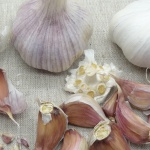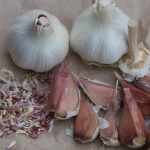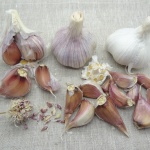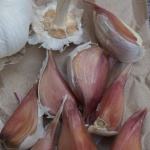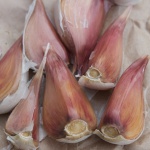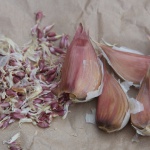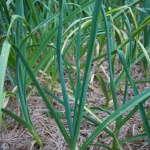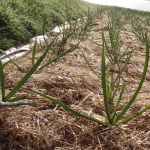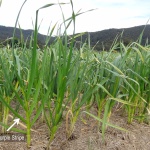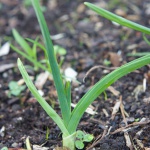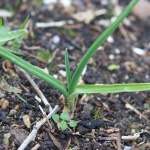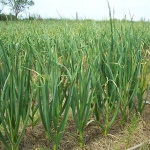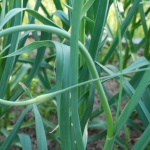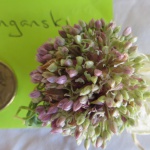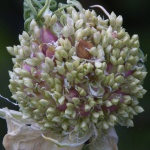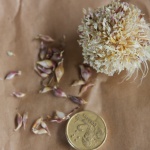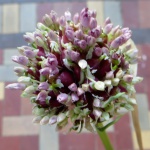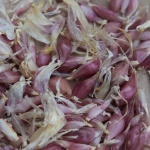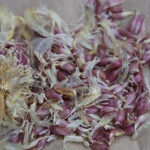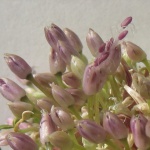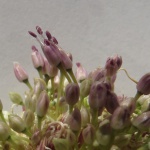Dunganski
Standard Purple Stripe Group Hardneck – Strongly Bolting
The Dunganski cultivar was sourced from a bazaar in Samarkand Uzbekistan in 1989 (US NGPS W6 1861) and should not be confused with the Marbled Purple Stripe cultivar (US NGPS) W6 1859 sourced from Kazakhstan also named Dunganski.
This cultivar was imported in 1994 by the AGIA, Loxton Var. No: 5, CSIRO Intro No: 135531, but failed to grow.
There have been several more recent successful importations of Dunganski into Australia. Growers include David Cusato, who now grows in Campania Tasmania sourced via Dr Fred Crowe (USA Virus Free Seed Grower) and Letetia Ware Southern Tasmania also sourced via Dr Fred Crowe.
General Information
| Other Names | Duganski |
|---|---|
| International Names | Known in the US as Duganski (US NGPS W6-1861). Also known as Dunganskij, Samarkand |
| Flavour | Very good. Raw moderate to hot. Cooked a lovely nutty flavor. Very nice baked whole. |
| Storage | Medium |
| Growing location | Grows best in cool climates, but does produce a reasonable crop in milder climates. Grown commercially in Tasmania and in West Australia (as far North as Perth). In warmer areas may get a better crop by cooling bulbs for a few weeks prior to planting. In the same areas, bulb size may diminish over time. |
| Growing requirements | Quite easy. Scapes need to be removed before uncoiling in order to grow full size bulbs. |
| Planting and harvest | Late planting and harvest. |
Bulb
| Shape |
Round and flattish although a little taller than most. Medium to large bulbs about 6 to 7cm with the very large bulbs starting to distort shape. |
|---|---|
| Skin colour and texture |
Freshly dug the bulbs are light purple on white. The inner skins are white with some having a small amount of purple striping. The skins are thick on the outside but thin as you go in, they cover the bulbs well. They flake off in pieces when you try to peel, the last layer sticks very tightly to the bulb. |
Clove
| Number and layout |
Can vary depending on climate and feeding regime. In cool climes typically 8 to 10 large cloves, in warmer climes 10 to 15 large cloves. In heavy feeding regimes can have up to 17 large cloves. Usually in a single layer. |
|---|---|
| Size and shape |
Medium to large cloves with average weight of 6 gm. Cloves are crescent shaped and taller than most. Cloves also have quite long paper tails. Most cloves have 3 flat sides with reasonably sharp edges but some of the larger cloves are plumper and rounder with little edging or strong angles. Other cloves have 2 flat sides and are quite deep. |
| Skin colour and texture |
Quite variable. Some seasons purple on shiny dark tan, other seasons much more shiny purple on light tan some seasons some have purple stripes and a bit to a lot of purple on white and others are even cranberry. Skins medium thick and reasonably easy to peel but harder to peel than Rocambole as the skins are thinner and stick a bit more tightly. Skins may split on older cloves and are then easy to peel. |
Plant
| Size and shape | Strong tall erect plants to about 1m (ex scape). |
|---|---|
| Leaves |
Medium width and stay reasonably straight at about 40 degree to stem. Leaves are spaced widely apart on the stem. |
| Young plants |
Start with 3 to 5 small leaves in circular arrangement around pseudostem. They develop into wide, spread, curly leaves flat to the ground. The plants keep a very low stature for about the first 8 leaves and then somewhere at about 12 weeks or later they do a rapid upright grow of several centimeters a week. |
| Matures | Strong plant. |
| Scape |
Sturdy scape that does a 270° tight loop before straightening. Beak is long 22 to 33cm. Umbel is about the size of $1 coin. Starts with a yellowish tinge & as it develops becomes whiter & fatter for first 2 to 3 cm. Remove the scape before it finishes its full turn, to produce the biggest bulbs. |
| Umbel and beak | Beak is long 22 to 33cm. Umbel is about the size of $1 coin. Starts with a yellowish tinge and as it develops becomes whiter and fatter for first 2 to 3 cm. |
| Bulbils and flowers |
Large number of strong purple flowers. Flowers have been known to produce fertile seed. Purple anthers in flowers are believed to indicate that the flowers are fertile. 100-200 bulbils, typically 1-3 x rice. Various shapes mainly plump and a bit taller than many. Deep purple. |
